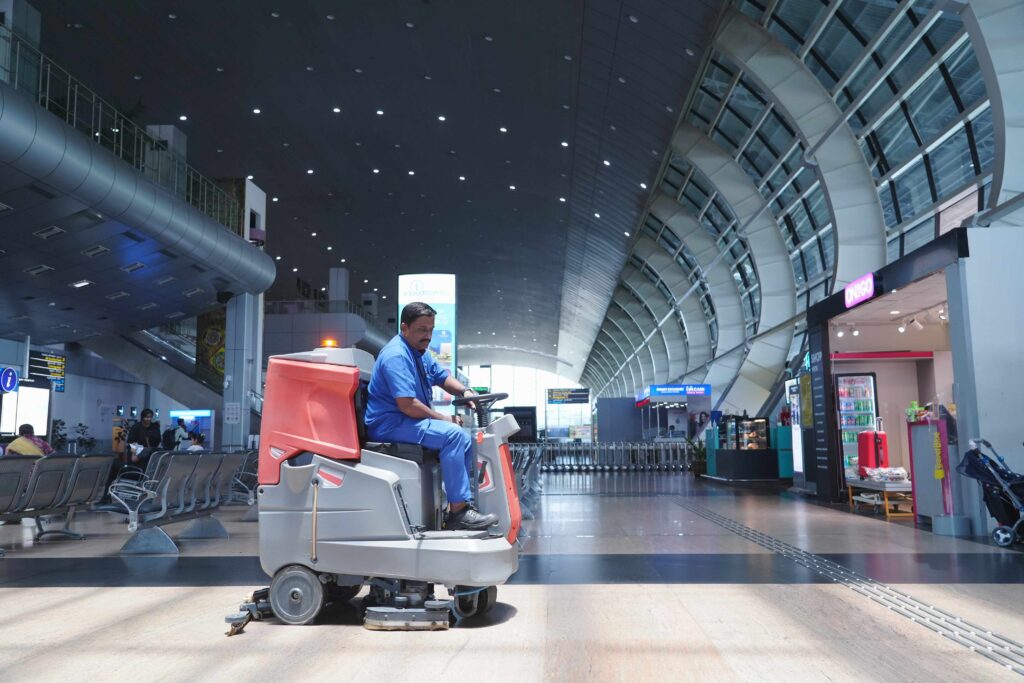
Airports, be it big or small, require the right hands to maintain, implement processes, retain quality and to ensure consistency. This responsibility largely is outsourced to service providers who not only maintain but “conduct routine inspections to ensure all facilities, equipment and infrastructure are in optimal condition. We expect energy efficient practices and technologies to be implemented to minimize environmental impact”, says Rahul Bhatkoti, Chief Airport Officer, Thiruvananthapuram International Airport. Excerpts of the interview with Clean India Journal.
What are the new technologies introduced for a better commuter experience concerning hygiene, cleanliness, and food safety among others?
One is the implementation of the Adani One app that is focused on enhancing user experience and reducing waiting time of passengers for accessing various retail options. The idea of Boarding Bytes has been projected so that the passengers can avail these benefits within flight. Full-fledged implementation of the Digi yatra app in the airport will facilitate contactless ID check and help in faster verification at the boarding gates.
Zero Waste is our goal. Our aim is to generate less waste and strive to reuse and recycle materials for the same purpose or for secondary use.
In keeping with the sustainability goals given by our PM, what are the initiatives taken towards carbon footprint, water conservation, ESG, and net zero?
Thiruvananthapuram International Airport (TIA) recognizes the significance of conserving energy and reducing emissions for ensuring sustainable business operations. We are committed towards enhancing energy efficiency and absolute GHG emission reduction through various interventions and collaborative efforts with the stakeholders. Also, the company aspires to achieve a leadership position in the Airport Carbon International’s (ACI) Airport Carbon Accreditation (ACA) Program. The ACA is the only institutionally endorsed, global carbon management certification program for airports. TIAL will strive to achieve carbon neutrality and ACA level 4+ status in 2025.
Commitments of TIAL
Operational Net Zero: 2029
Carbon Neutrality: 2025
ACA Level 4+ accreditation: 2025
Zero Waste to Landfill Certification: 2024
Environment management
The Airport is certified for Integrated Management System Certification. (ISO 9000:2015, ISO 14000 :2015, ISO 45001 :2018)
It is also certified for Energy Management System (ISO 50001:2018) Certification.
Regular Environment Monitoring is being carried out at site and all the parameters are within the standard norms. TIA is effectively implementing an Environment Management Plan across the site and is regularly carrying out environment monitoring with respect to air, noise, water, wastewater and soil. Reports are being submitted to all the regulatory authorities, as a part of the Six-Monthly Compliance report.

Solid Waste Management
The Airport waste management is based on the cradle-to- cradle concept wherein the focus is on Reduce, Reuse, Recycle, Reprocess, Recover, and upcycle the waste back into the system. It also comprises five stages – Identification, Storage, Segregation, Recycling and Disposal. All the waste generated from airport operations is being collected, segregated at source into hazardous and non-hazardous categories, stored and disposed of by adhering to applicable regulatory requirements.
The process to achieve an efficient sustainable waste management is guided by four major goals under the Zero Waste Initiative which follows 5R Principles.
• Zero Waste to Landfill
• Zero Incineration
• Zero Unauthorized Disposal
• Zero Effluent Discharge
We ensure that food and organic waste is converted into biogas which is then converted to electrical energy and used for operations. In fact, our airport has completely converted organic wastes to biogas. The airport complies with all applicable EHS requirements to ensure that materials are processed in the most environmentally sound manner.
The operations and activities of both the international and domestic terminals generate around 350 kg organic waste every day. To manage this waste in a sustainable way, an organic waste-biogas power generating unit for treating 500 kg/day has been set up based on the CSIR-NIIST technology.
Energy Savings
Installed Capacity of Renewable source of energy is 0.5MW
The conventional lights have been replaced with LED lights in all the possible locations which has reduced the total energy consumption. The number of chillers at airport premises are reduced by combining the chiller lines of Arrival & Departure areas. Proactively controlled lighting systems are provided. The landside streetlights are made operational on timer basis according to the daylights.
Sensitization of the team & continuous follow-up is done for further improvising the airport environmental & sustainability aspects.
Timely maintenance and monitoring of AHU’s filters & coil, chillers, cooling towers is being carried out at TIA. Regular monitoring is also being carried out for the same. Six Electrical vehicles (e-vehicles) are introduced at TIA, for operations to reduce the GHG emissions.
Reduction of CO2 emissions
Reduction of Scope 1 Emissions is achieved through many measures.
Like deploying 14 Electric Vehicles – (12 Cars & 2 Golf Cart Vehicles), converting of R22 refrigerants to R32 refrigerants and building systems optimization (HVAC, BMS). Conversion of conventional lamps into LEDs is in the final stages in all areas.
By 2024, it is proposed to install captive on-site solar/wind power plants, purchase renewable/green electricity via Power Purchase Agreements from renewable energy suppliers and purchase Renewable Energy Certificate (REC) to offset scope 2 emissions.
Another move is the conversion of airport operators’ conventional vehicles (except fire tenders and tugs designated for towing of cargo and passenger transport) to EVs for Airport Operator’s Fuel emission reduction by March 2024.
For emissions associated with fire tenders and tugs designated for towing of cargo and passenger transport, purchase Certified Emission Reductions (CERs) – carbon credits.
In terms of maintenance and sustainability, there is a need to discussing best practices and initiatives that benefit the stakeholders can be a good measure.
Water treatment and disposal/recycling
A Sewage Treatment Plant (Activated Sludge Process based STP) of 500 KLD is installed at the site for treating and handling the domestic sewage generated from airport premises. The treated wastewater is utilized for gardening and horticulture activity within airport premises.
Water Conservation
As part of water conservation, water taps have been installed with sensors in all the washrooms of the Terminal building. Dry cleaning of solar panels is being carried out instead of water wash. Treated water from the STP is utilized for gardening & horticulture purposes.
Air Management
Ambient Air Quality (10km radius around the airport) & Environment Monitoring for D.G Stack Flue Gas Emissions is carried out by engaging MoEF&CC & NABL accredited laboratory, and all the results are observed to be within stipulated standards.
The study area represents, mostly suburban environment with sources of air pollution like vehicular traffic, domestic fuel burning and aircraft movement in the vicinity of the take-off & landing corridors. Thus, there are three ambient air quality monitoring stations covering both upwind and downwind directions.
Environment Monitoring for Soil Analysis is also being carried out by MoEF&CC and NABL.
Biodiversity & Wildlife Management
Non-destructive Wildlife Hazard Management techniques are practiced and organic chemical spray is carried out to control weeds & grass. Five acres of green cover with local native plants and 3,100sqm of herbal park are developed. Airside inspection is practiced at regular intervals and accordingly the wild animals are relocated to the safer areas.
Noise control & biodiversity
Following safeguard measures are taken for abatement of noise emissions:
• DG Set has acoustic enclosures & muffs
• Maintaining the Continuous Descent approach by the aircrafts
• Standard instrument arrival & departure procedure is implemented to minimize the noise levels of aircrafts
• Control on the vehicular noise level by maintaining speed & vehicle conditions
How would you redefine the role of a new airport in today’s era?
An airport needs to be utilitarian as well as project the modern world in its design and layout. Ease of usage with proper guidelines even to people unfamiliar with the proceedings of a normal airport is mandatory. Implementing advanced technologies like automated check in process, smart trolleys, having recreation centres for passengers with long layover, and the overall aesthetics will definitely have positive impacts on the passengers.
What are the new technologies that have been introduced in TIA in terms of traffic management systems, safety, logistics, 5G, and transportation?
In terms of transportation, SKIDATA and FASTag systems have been introduced in place of the DIVC system. When vehicles are entering the airport, a metal detector provided just before the boom barrier can sense the vehicle after which a coupon is generated by pressing the button. Then the boom barrier is raised for the vehicle to pass through. Barcode scanner is used for scanning the coupon to calculate the parking fee when the vehicle is exiting. In the case of the FASTag system, the tags on the vehicles are scanned while entering and exiting the airport and money is deducted accordingly. There are Wi-Fi kiosks provided inside the terminal, which generate coupons to passengers for internet connectivity.
Considering both international and domestic terminals, approximately 13,000 passengers travel per day. Eighteen airlines are currently operating from the airport and there are two ground handling agencies at present. There are more than 50 concessionaires, retail outlets and other statutory agencies.


































